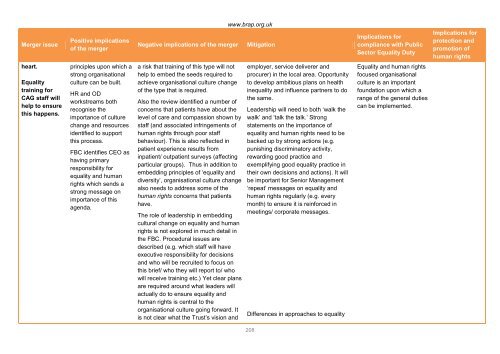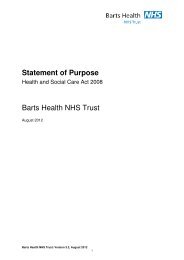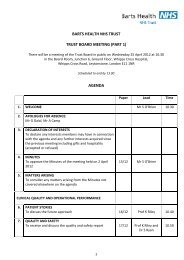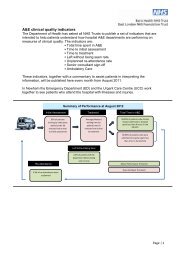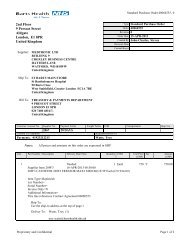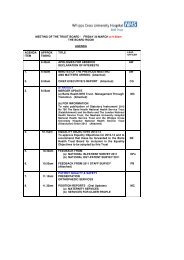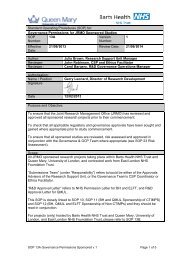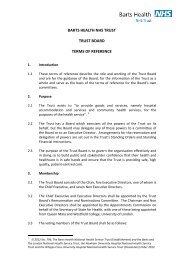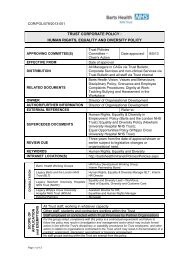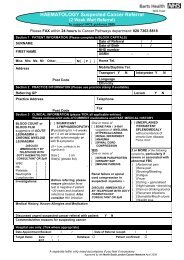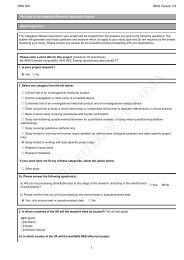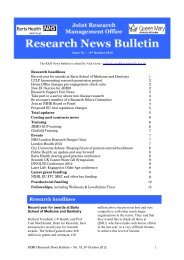Barts Health Equality and Human Rights Impact Assessment Report
Barts Health Equality and Human Rights Impact Assessment Report
Barts Health Equality and Human Rights Impact Assessment Report
- No tags were found...
Create successful ePaper yourself
Turn your PDF publications into a flip-book with our unique Google optimized e-Paper software.
Merger issuePositive implicationsof the mergerNegative implications of the mergerwww.brap.org.ukMitigationImplications forcompliance with PublicSector <strong>Equality</strong> DutyImplications forprotection <strong>and</strong>promotion ofhuman rightsheart.<strong>Equality</strong>training forCAG staff willhelp to ensurethis happens.principles upon which astrong organisationalculture can be built.HR <strong>and</strong> ODworkstreams bothrecognise theimportance of culturechange <strong>and</strong> resourcesidentified to supportthis process.FBC identifies CEO ashaving primaryresponsibility forequality <strong>and</strong> humanrights which sends astrong message onimportance of thisagenda.a risk that training of this type will nothelp to embed the seeds required toachieve organisational culture changeof the type that is required.Also the review identified a number ofconcerns that patients have about thelevel of care <strong>and</strong> compassion shown bystaff (<strong>and</strong> associated infringements ofhuman rights through poor staffbehaviour). This is also reflected inpatient experience results frominpatient/ outpatient surveys (affectingparticular groups). Thus in addition toembedding principles of ‘equality <strong>and</strong>diversity’, organisational culture changealso needs to address some of thehuman rights concerns that patientshave.The role of leadership in embeddingcultural change on equality <strong>and</strong> humanrights is not explored in much detail inthe FBC. Procedural issues aredescribed (e.g. which staff will haveexecutive responsibility for decisions<strong>and</strong> who will be recruited to focus onthis brief/ who they will report to/ whowill receive training etc.) Yet clear plansare required around what leaders willactually do to ensure equality <strong>and</strong>human rights is central to theorganisational culture going forward. Itis not clear what the Trust’s vision <strong>and</strong>employer, service deliverer <strong>and</strong>procurer) in the local area. Opportunityto develop ambitious plans on healthinequality <strong>and</strong> influence partners to dothe same.Leadership will need to both ‘walk thewalk’ <strong>and</strong> ‘talk the talk.’ Strongstatements on the importance ofequality <strong>and</strong> human rights need to bebacked up by strong actions (e.g.punishing discriminatory activity,rewarding good practice <strong>and</strong>exemplifying good equality practice intheir own decisions <strong>and</strong> actions). It willbe important for Senior Management‘repeat’ messages on equality <strong>and</strong>human rights regularly (e.g. everymonth) to ensure it is reinforced inmeetings/ corporate messages.Differences in approaches to equality<strong>Equality</strong> <strong>and</strong> human rightsfocused organisationalculture is an importantfoundation upon which arange of the general dutiescan be implemented.208


